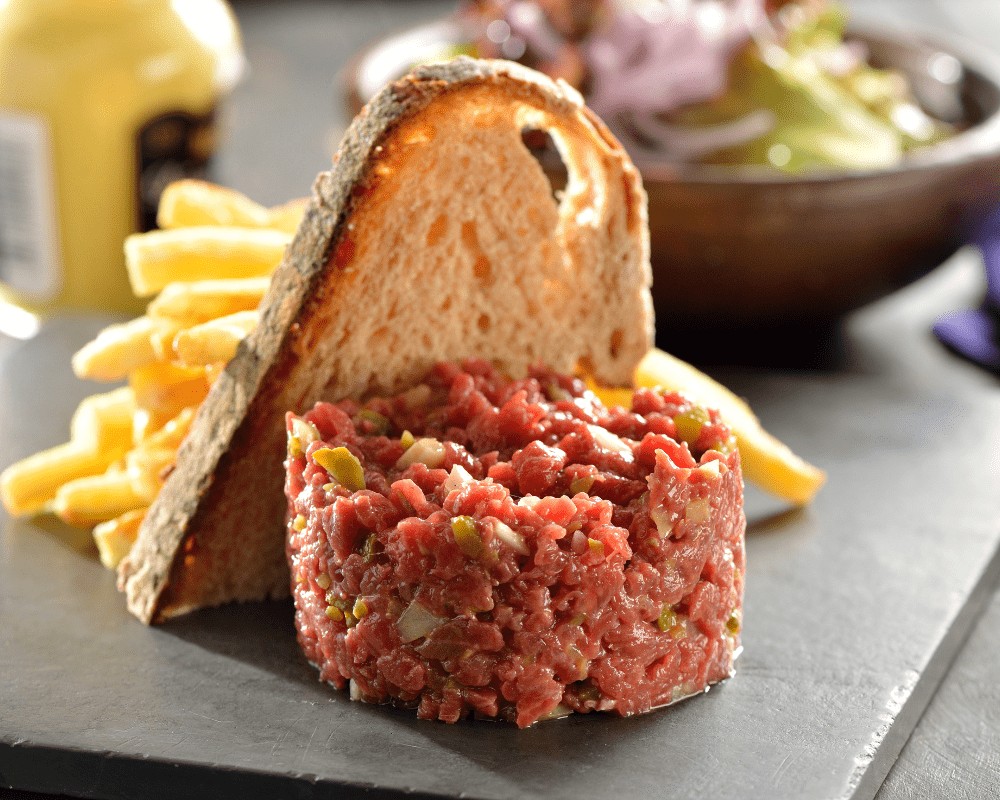Tartare is a culinary preparation featuring raw, ground, or finely chopped meat or fish. Craving to discover more about this dish? WHAT.EDU.VN provides insights into its preparation, safety, and variations. Explore the world of tartare, understand its nuances, and maybe even find a new favorite way to enjoy this delicacy. Delve into culinary arts, raw meat dishes, and French cuisine.
1. Defining Tartare: A Culinary Classic Explained
Tartare, at its core, is a dish that celebrates the pure, unadulterated flavor of raw ingredients. While the term “tartare” can apply to various preparations, it’s most commonly associated with finely chopped raw beef, known as steak tartare or beef tartare. However, tartare’s versatility extends beyond beef, encompassing fish (like tuna or salmon), vegetables, and even fruits. The key characteristic remains the same: raw ingredients, meticulously prepared and seasoned to create a flavorful and texturally interesting experience.
1.1. Etymology and Historical Origins of Tartare
The origins of the word “tartare” are shrouded in a bit of culinary mystery. One popular theory connects it to the Tatars, a nomadic group from Central Asia. Historically, rumors circulated that the Tatars consumed raw meat, which led to the association of their name with dishes prepared in a similar manner. However, it’s important to note that this connection is largely based on anecdotal accounts and may not accurately reflect the Tatars’ actual culinary practices.
While the etymological link remains debatable, the concept of consuming raw meat dishes has existed for centuries across various cultures. From ancient nomadic tribes to medieval Europe, the practice of eating uncooked meat was driven by factors such as necessity, preservation techniques, and even perceived health benefits.
1.2. Traditional Steak Tartare: Ingredients and Preparation
Steak tartare, the quintessential tartare preparation, is a testament to simplicity and quality. The core ingredient is, of course, high-quality raw beef, typically lean cuts like filet mignon or sirloin. The beef is meticulously minced or finely chopped to ensure a tender and pleasant texture.
Beyond the beef, steak tartare relies on a carefully curated selection of seasonings and accompaniments to elevate its flavor profile. Common ingredients include:
- Egg yolk: Often served atop the tartare, the yolk adds richness, creaminess, and a luxurious mouthfeel.
- Onions or shallots: Finely minced, these alliums contribute a pungent bite and aromatic complexity.
- Capers: These briny buds provide a salty and acidic counterpoint to the richness of the beef.
- Mustard: Dijon mustard is a classic choice, adding a tangy and spicy kick.
- Worcestershire sauce: This umami-rich sauce lends depth and savory notes.
- Fresh herbs: Parsley, chives, or tarragon contribute freshness and herbaceous aromas.
- Salt and pepper: Essential seasonings to enhance the natural flavors of the ingredients.
The preparation of steak tartare is a delicate balance of precision and taste. The ingredients are carefully combined, ensuring that the flavors meld harmoniously without overpowering the delicate taste of the raw beef. The tartare is then typically formed into a patty or mound and served chilled, often with toast points, fries, or salad as accompaniments.
1.3. Beyond Beef: Exploring Other Tartare Variations
While steak tartare reigns supreme, the world of tartare extends far beyond beef. Fish tartare, particularly tuna and salmon, has gained immense popularity, offering a lighter and more refreshing alternative. Vegetable tartare, featuring ingredients like beets, avocados, or tomatoes, caters to vegetarian and vegan palates, showcasing the versatility of this culinary preparation.
- Fish Tartare: Typically made with sushi-grade tuna or salmon, fish tartare is often seasoned with soy sauce, sesame oil, ginger, and wasabi, reflecting Asian-inspired flavors.
- Vegetable Tartare: Vegetable tartare offers a vibrant and colorful option, incorporating a variety of finely diced vegetables, herbs, and vinaigrette dressings.
2. Is Tartare Safe? Addressing Food Safety Concerns
The consumption of raw meat or fish naturally raises concerns about food safety. While tartare can be a safe and enjoyable culinary experience, it’s crucial to understand the potential risks and take appropriate precautions.
2.1. Potential Risks Associated with Raw Meat and Fish Consumption
Raw meat and fish can harbor bacteria, parasites, and viruses that can cause foodborne illnesses. The specific risks vary depending on the type of meat or fish, its origin, and how it has been handled and stored.
- Bacteria: Common bacteria found in raw meat include Salmonella, E. coli, and Campylobacter. These bacteria can cause symptoms such as diarrhea, vomiting, abdominal cramps, and fever.
- Parasites: Raw fish can contain parasites like Anisakis, which can cause gastrointestinal distress.
- Viruses: While less common, raw meat and fish can also be contaminated with viruses like norovirus, which can cause vomiting and diarrhea.
2.2. Minimizing Risks: Choosing High-Quality Ingredients
The most critical step in ensuring the safety of tartare is to source high-quality ingredients from reputable suppliers. When purchasing beef or fish for tartare, look for the following:
- Freshness: Choose meat or fish that is exceptionally fresh, with a bright color and no off-putting odors.
- Source: Opt for meat or fish from trusted butchers or fishmongers who adhere to strict hygiene standards.
- Certification: Look for certifications that indicate the meat or fish has been inspected and meets specific safety standards.
2.3. Proper Handling and Storage Practices
Proper handling and storage are essential to prevent the growth of bacteria and minimize the risk of contamination. Follow these guidelines:
- Keep it cold: Store raw meat and fish at a temperature of 40°F (4°C) or below.
- Prevent cross-contamination: Use separate cutting boards and utensils for raw meat and fish to avoid transferring bacteria to other foods.
- Wash your hands: Wash your hands thoroughly with soap and water before and after handling raw meat and fish.
- Limit time at room temperature: Do not leave raw meat or fish at room temperature for more than two hours.
2.4. Who Should Avoid Eating Tartare?
Certain individuals are at higher risk of developing foodborne illnesses and should avoid eating tartare:
- Pregnant women: Pregnant women are more susceptible to Listeria infection, which can be harmful to the fetus.
- Young children: Young children have less developed immune systems and are more vulnerable to foodborne illnesses.
- Elderly individuals: Elderly individuals often have weakened immune systems and are more susceptible to complications from foodborne illnesses.
- Individuals with compromised immune systems: People with weakened immune systems due to illness or medication should avoid eating raw meat and fish.
If you have any concerns about the safety of eating tartare, consult with your doctor or a registered dietitian.
3. Preparing Tartare: A Step-by-Step Guide
Making tartare at home can be a rewarding culinary experience. By following these steps and adhering to food safety guidelines, you can create a delicious and safe tartare dish.
3.1. Selecting the Right Cut of Beef or Fish
The choice of meat or fish is crucial for the success of your tartare. For steak tartare, lean and tender cuts like filet mignon, sirloin, or tenderloin are ideal. For fish tartare, sushi-grade tuna or salmon are excellent choices.
3.2. Mincing or Chopping Techniques for Optimal Texture
The texture of tartare is just as important as its flavor. Finely mincing or chopping the meat or fish ensures a tender and pleasant mouthfeel. You can use a sharp knife or a meat grinder to achieve the desired texture. If using a knife, ensure it is extremely sharp to avoid bruising the meat.
3.3. Seasoning and Flavoring Tartare: Classic and Creative Options
The seasoning and flavoring of tartare is where you can truly express your culinary creativity. While classic steak tartare relies on ingredients like egg yolk, onions, capers, and mustard, you can experiment with other flavors and ingredients to create your own signature tartare.
- Asian-inspired: Soy sauce, sesame oil, ginger, wasabi, and sriracha.
- Mediterranean: Olive oil, lemon juice, garlic, oregano, and feta cheese.
- South American: Lime juice, cilantro, chili peppers, and avocado.
3.4. Plating and Presentation Ideas for an Appealing Dish
The presentation of tartare can elevate it from a simple dish to a culinary masterpiece. Consider these plating ideas:
- Classic patty: Form the tartare into a patty or mound and top with an egg yolk.
- Deconstructed: Arrange the individual ingredients separately on the plate, allowing diners to customize their tartare.
- In a shell: Serve fish tartare in a scallop shell or other decorative shell.
- With accompaniments: Offer a variety of accompaniments, such as toast points, crackers, fries, or salad.
4. Tartare Around the World: Regional Variations and Influences
Tartare, in its various forms, has found its way into cuisines around the world, with each region adding its own unique twist and flavor profiles.
4.1. French Steak Tartare: A Culinary Icon
As we have already discussed, French steak tartare is the quintessential tartare preparation, characterized by its simplicity and reliance on high-quality ingredients. It is a staple in French bistros and restaurants, often served as a starter or main course.
4.2. Korean Yukhoe: A Sesame-Infused Delight
Yukhoe is a Korean version of steak tartare, featuring thinly sliced raw beef seasoned with soy sauce, sesame oil, garlic, ginger, and a touch of sweetness. It is often served with a raw egg yolk and Korean pear.
4.3. Ethiopian Kitfo: Spiced and Savory
Kitfo is an Ethiopian dish made with minced raw beef marinated in a blend of spices, including mitmita (a chili powder blend), cardamom, and coriander. It is typically served with injera, a spongy flatbread.
4.4. Other Regional Variations and Adaptations
- Italy: Carne Cruda, a Piedmontese specialty featuring finely chopped raw beef seasoned with olive oil, lemon juice, and salt.
- Denmark: Tatar, a dish similar to steak tartare, often served with rye bread and various toppings.
- Japan: While not technically tartare, dishes like sushi and sashimi showcase the Japanese appreciation for raw fish.
5. Common Questions About Tartare Answered
Navigating the world of tartare can bring up a variety of questions. Here are some answers to frequently asked questions:
| Question | Answer |
|---|---|
| What exactly is tartare made of? | Tartare traditionally consists of raw, finely chopped or minced meat (usually beef) or fish. It’s then seasoned with various ingredients like onions, capers, mustard, Worcestershire sauce, and often topped with a raw egg yolk. |
| Is it safe to eat raw meat? | Eating raw meat carries risks of foodborne illness. To minimize these risks, choose high-quality, fresh meat from reputable sources, and follow strict hygiene practices during preparation. Certain individuals, like pregnant women and those with weakened immune systems, should avoid eating raw meat. |
| How do you make tartare? | Making tartare involves finely chopping or mincing the meat, then mixing it with seasonings and accompaniments. Recipes vary, but common ingredients include onions, capers, mustard, egg yolk, and herbs. |
| What does tartare taste like? | Tartare has a rich, savory flavor with a delicate texture. The taste depends on the type of meat or fish used and the seasonings added. The raw egg yolk contributes to a creamy mouthfeel. |
| What is the origin of tartare? | The origin of tartare is debated, but it’s often associated with the Tatars, a nomadic group from Central Asia. The modern version of steak tartare is believed to have originated in France. |
| What are some variations of tartare? | Besides steak tartare, popular variations include tuna tartare, salmon tartare, and vegetable tartare. These variations use different ingredients and seasonings to create unique flavor profiles. |
| How should tartare be served? | Tartare is typically served chilled, often as an appetizer or main course. It’s commonly accompanied by toast points, crackers, fries, or salad. |
| Can vegetarians enjoy tartare? | Yes, vegetable tartare offers a vegetarian option. It’s made with finely diced vegetables like beets, avocados, or tomatoes, seasoned with herbs and vinaigrette. |
| What are some good wine pairings? | The ideal wine pairing for tartare depends on the type of meat or fish and the seasonings used. In general, dry white wines or light-bodied red wines are good choices. |
| Where can I find the best tartare? | The best tartare is often found in reputable restaurants or bistros that specialize in French cuisine or raw seafood. It’s also possible to make delicious tartare at home with high-quality ingredients and careful preparation. |


6. Culinary Tips and Tricks for Tartare Perfection
Elevate your tartare game with these expert tips and tricks:
- Use the freshest ingredients: The quality of the ingredients is paramount when preparing tartare.
- Keep everything cold: Chilling the meat, fish, and utensils helps to prevent bacterial growth.
- Don’t overmix: Overmixing can make the tartare tough.
- Taste and adjust: Season the tartare to your liking, adjusting the flavors as needed.
- Serve immediately: Tartare is best served immediately after preparation.
7. Embrace the Tartare Adventure
Tartare, a dish steeped in history and culinary tradition, offers a unique and flavorful experience for adventurous eaters. By understanding the potential risks, following food safety guidelines, and experimenting with different flavors and ingredients, you can confidently explore the world of tartare and create your own culinary masterpieces.
7.1. Encouraging Responsible Consumption and Exploration
As with any raw food preparation, responsible consumption is key. Choose high-quality ingredients, practice proper handling and storage, and be mindful of individual risk factors. With these precautions in mind, you can savor the unique flavors and textures of tartare without compromising your health and well-being.
7.2. Sharing Your Tartare Creations and Experiences
Have you tried making tartare at home? Share your recipes, tips, and experiences with the online culinary community. Exchange ideas, inspire others, and celebrate the art of tartare preparation.
7.3. Seeking Further Information and Resources
For more in-depth information on tartare, consult reputable culinary resources, food safety organizations, and registered dietitians. Expand your knowledge, refine your techniques, and continue your culinary journey.
Are you curious about other culinary dishes, ingredients, or cooking techniques? Don’t hesitate to ask your questions on WHAT.EDU.VN. Our community of experts and enthusiasts is ready to provide you with reliable and informative answers, completely free of charge.
8. Call to Action: Your Questions Answered on WHAT.EDU.VN
Do you have lingering questions about tartare, its safety, preparation, or variations? Are you seeking culinary advice, recipe ideas, or food safety tips? Look no further than WHAT.EDU.VN. Our platform offers a wealth of information, expert guidance, and a supportive community to answer all your culinary queries.
8.1. Submit Your Questions and Receive Free Answers
At WHAT.EDU.VN, we believe that knowledge should be accessible to everyone. That’s why we offer a free question-and-answer platform where you can submit your queries and receive timely and accurate responses from our team of experts and community members. Whether you’re a seasoned chef or a curious home cook, we’re here to help you navigate the culinary world with confidence.
8.2. Connect with a Community of Food Enthusiasts
Join our vibrant community of food enthusiasts, share your culinary experiences, and learn from others. Exchange recipes, tips, and tricks, and discover new and exciting ways to explore the world of food.
8.3. Contact Us for Further Assistance
If you have any questions or need further assistance, please don’t hesitate to contact us. Our dedicated team is here to provide you with the support you need to succeed in your culinary endeavors.
Contact Information:
- Address: 888 Question City Plaza, Seattle, WA 98101, United States
- WhatsApp: +1 (206) 555-7890
- Website: WHAT.EDU.VN
Don’t let your culinary questions go unanswered. Visit what.edu.vn today and unlock a world of culinary knowledge, completely free of charge. We look forward to helping you on your culinary journey.
